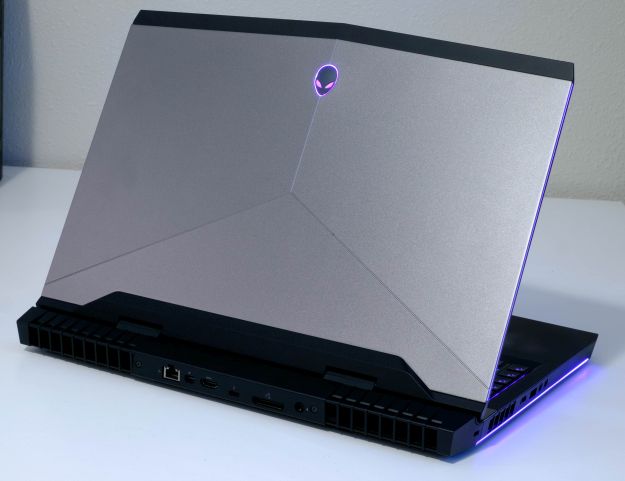Alienware 17 R4 2017 Gaming Laptop Review: Powerful And Refined
Alienware 17 R4 2017: Gaming Design and Features
The Alienware 17 is a hefty notebook with an average weight of 9.74-pounds. It’s not something you want to use on your lap for extended amounts of time either. Heftiness aside, it’s a stylish laptop with a high-quality look and feel thanks to a combination of anodized aluminum and rubberized plastic surfaces. The iconic Alien head is proudly displayed on the aluminum top cover to show that it’s an Alienware machine. Kudos to Dell for keeping styling subtle, so the Alienware 17 can blend in at a LAN party and in a professional environment, should you tone down the lighting perhaps.
RGB lightning appears in small strips on each side of the Alienware 17, the Alien head, and in the trackpad and keyboard. I found the lit trackpad odd at first boot, but came to appreciate it after a little while. It’s an extra subtle detail that makes the Alienware 17 stand out from plain black or gray-equipped gaming notebooks. There’s 13 total programmable lighting zones adjustable via the AlienFX app, so you can adjust the colors to your heart's content. Games can take advantage of the AlienFX lighting for ambient lighting effects too (where supported), but I preferred a simple single-color arrangement.
A steel-reinforced TactX keyboard provides 2.2mm of travel, RGB lighting, numpad and 9 macro keys. It’s still a membrane keyboard and feels somewhat mushy. However, the mushiness versus a mechanical plank doesn’t hinder typing speed or gaming abilities. I found the keys too wide for my taste, but I have smaller hands that feel more at home on ultrabooks. The keyboard surface’s rubberized texture claims to have a finishing process that reduces smudges and fingerprints, but my sweaty and Cheetos-dust-covered palms still made their mark on the palm rests. Thankfully, the surfaces are easily cleaned.
Tobii eye-tracking is integrated below the LCD panel behind a strip of gloss black plastic trim. The technology is really cool, in theory. Being able to look at an icon on the Windows desktop and tapping the touch pad to have it immediately move there, looking at the Alien head above the keyboard to wake up the notebook, and using eye-tracking for aiming in games is a nifty feature, but it’s not something I found useful during everyday use nor did it work flawlessly – it didn’t detect my eyes’ gaze as often as I tried to use it. It’s a novel feature, that is still in need of some refinement. You can see the Tobii eye-tracking in action in the video embedded on the first page.
Our test unit came with the QHD (2560x1440) 120 Hz panel that also supports NVIDIA’s G-SYNC technology. The downside of the faster panel with G-SYNC is the twisted nematic (TN) LCD technology used instead of the in-plane switching (IPS) technology of the standard 1080p and optional 4K UHD panels. G-SYNC technology and the 120 Hz panel makes gaming look extremely fluid and smooth, and it helps minimize lag too. Thankfully, the typical shortcomings of a TN panel, like washed out colors and poor off-angle viewing, aren't as prevalent on the Alienware 17. As far as TN panels go, the one used in this machine is of very high quality.
Alienware touts the 17’s hinge-forward design that enables it to have a useful array of rear ports, which is excellent if you’re OCD about cable management like I am. There’s a Gigabit Ethernet port powered by a Killer Networks e2400 controller, mini-DisplayPort 1.2, HDMI 2.0, USB-C with Thunderbolt 3, SuperSpeed USB and DisplayPort connectivity, an Alienware Graphics Amplifier port and the power input jack. The vast rear port array makes it easy to hook up the Alienware 17 with any peripherals, displays and cables you need for a clean desk arrangement, assuming you have a USB-C hub or Graphics Amplifier.
The rest of the Alienware 17 is quite spartan. The left side contains a USB-C port, USB 3.0 port, microphone input and audio output, while the right side has a single USB 3.0 port. Missing is an SD card reader, which is a shame because the Alienware 17 has the chops to make an excellent video and image editing machine when paired with the IPS display option.
Upgrading the Alienware 17 is easy – remove seven screws and gently pry open the cover to gain access to the internals. Storage and RAM are the only two things you can upgrade in the notebook, however. There's three m.2 slots capable of supporting SATA or PCIe drives and a 2.5-inch drive bay. Only two of the m.2 slots are 2280 size, which supports the latest 2TB SSDs, but larger retail 2260 drives are harder to come by. Up to 32GB of RAM is supported in the Alienware 17, but all configurations ship with two modules installed for dual channel operation.













